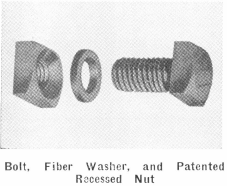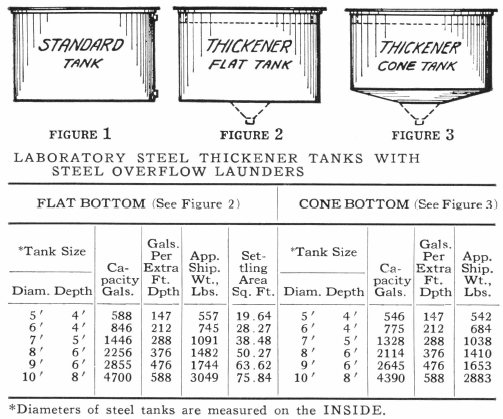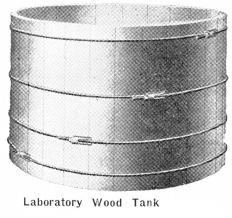Bolted Steel Laboratory Tank
Bolted Steel Laboratory Tank is ideal for use in any ore dressing or metallurgical laboratory. This tank may be used as an ore bin, for solution or water storage, etc., in batch testing laboratories; and as an agitator, conditioner, or thickener tank in continuous pilot test plants. The fact that it is built in sections and packed “Knocked Down” simplifies installation, and it can be set up by unskilled workmen. Also its depth may be increased or decreased, or a damaged section replaced, without difficulty. It can be easily dismantled, moved, and reassembled in another section of the laboratory without enlarging doorways or troublesome moving of equipment. This feature makes it particularly suitable for laboratory use.

Bolted Steel Laboratory Tank is formed and punched so that it fits perfectly. The patented, leakproof nut insures a water-tight joint; the nuts are recessed with special oil-proof gaskets which stop any possibility of leaks around the threads of the bolts (as shown in the accompanying illustration). Standardization and quantity production make these tanks available at low cost. They are ideal for use in any locality and particularly for laboratories located in tropic or semi-tropic regions where wood tanks deteriorate rapidly.

While the diameters listed are standard, these Bolted Steel Laboratory Tanks can be furnished in any height. Where exact volume needed for your requirements is not indicated, use the standard diameter which most closely fits your problem; then increase the height to give the necessary capacity.

Welded Steel Laboratory Tank
Welded steel tanks are being used more and more extensively and are often more economical than wood tanks, particularly in the smaller sizes for laboratory use and wherever the fluid line varies considerably.
Modern flanging and high quality welding have made the use of the Welded Steel Laboratory Tank both practical and economical in all batch laboratories and continuous pilot test plants. This welded steel tank is widely used as a tank for laboratory agitators, conditioners, and thickeners, and for water or solution storage. Smaller sizes are easily portable and sturdy enough to withstand frequent moving.
Standard Welded Steel Laboratory Tanks are made with double welded construction. The side and bottom plates are of greater thickness than is normally supplied and added strength is also secured by an angle iron rim on the top. All standard laboratory tanks are sufficiently strong to stand the weight of the superstructures, rotating mechanisms, or flooring ordinarily used in ore dressing or metallurgical laboratories.
Tanks are shipped completely erected. If the standard specifications and sizes in the following table will not suit your requirements, tanks can be engineered for your needs.

 The diameters of steel tanks are measured on the INSIDE. Standard Laboratory Welded Steel Tanks have a flat bottom, heavy welded construction, and an angle iron rim.
The diameters of steel tanks are measured on the INSIDE. Standard Laboratory Welded Steel Tanks have a flat bottom, heavy welded construction, and an angle iron rim.

Wood Laboratory Tank
The Laboratory Wood Tank is the lowest priced tank manufactured for average laboratory applications. It is made of selected Douglas Fir, Redwood, Yellow Pine, or Cypress; whichever is best adapted to your particular laboratory problem. For example, where unusual climatic conditions occur and tank is to be used unprotected from the elements, as when used as an external water storage tank for a laboratory or in some other exposed place; recommendations are made using the most durable wood for those conditions. In tropical or semi-tropical countries, a special creosoted Red¬wood tank is preferable.
The Laboratory Wood Tank is made from the finest quality lumber, treated in dry kilns to retain the life of the wood and add to its strength and durability. Inside and outside of staves are milled to the true circular outline of the tank; and edges are dressed smooth to radial lines, ensuring water-tight joints.
Sufficient round hoops and lugs of proper size are furnished to provide strength for handling pulps or solutions of very high specific gravity; therefore tanks are well suited for use as agitator, conditioner, or thickener tanks and for all types of storage. Special features such as Pachuca, false or filter bottoms, inside or outside overflow launders, discharge flanges or doors either side or bottom, can be furnished on request.
Various capacities and weights are too numerous to list in this section.

DESCRIPTION OF FALSE AND FILTER BOTTOMS FOR TANKS
Style A: Bottom consists of grating of crozed strips 1¼”x1¾” Douglas Fir laid on edge 1¼” apart. Filter cloth protected by thin wood band 3/8″ thick placed around outer edge of these strips.
Style B: Bottom consists of grating of crozed strips 1¼”x1¾” Douglas Fir laid on edge and placed 2′ centers. On bottom strips is placed a grating made of 7/8″x7/8″ Douglas Fir strips spaced 1″ apart, a thin wood band 3/8″ thick is placed around the outer edge of strips.
Style C: Bottom constructed of 1″ Douglas Fir floor, provided with ½” holes approximately 2″ apart, and supported by croze strips.
Style E: Bottom does not require filter cloth. It consists of triangular strips about 3″x3″x3″, spaced ¼” apart and resting on crozed strips 1¼”x1¾” Douglas Fir, laid on edge 2′ centers. Spaces between triangular strips are filled with gravel, sand, and quartz, level with the upper edge.

